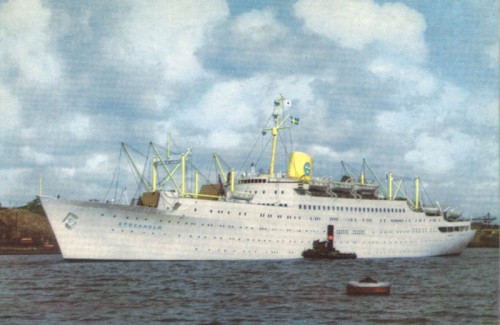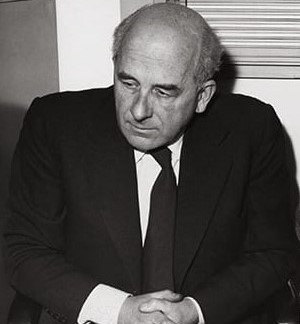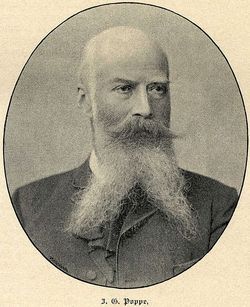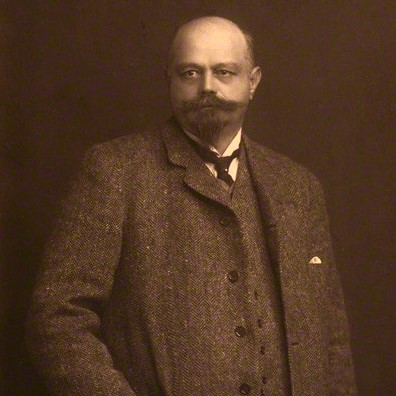Stockholm IV was ordered by Swedish American Line (SAL) in 1944 to replace the ageing Drottningholm of 1904, and was launched two years later on September 9, 1946 at the Götaverken shipyard in Gothenburg, Sweden. She was partly financed out of the proceeds of the sale of Stockholm III to the Italians in 1941 who used her as a troopship during the war.
She was technically designed by the well-known Swedish American Line nautical architect Eric Christiansson, who worked as the technical director at parent company Broström (a shipping concern that had operated cargo ships before getting involved in SAL). Her interiors featured artwork created by some of Sweden’s best known artists, among them Kurt Jungstedt, a famous painter.

At 160m and measuring 12,165GRT she was -although at the time the largest ship built in Sweden- in fact too small for the often angry North Atlantic. Stockholm carried a total of 395 passengers in two classes, first and tourist, and a limited cargo capacity of 3,000 tons . She sailed in tandem with fleetmate Gripsholm. Her maiden voyage took place on February 21, 1948, starting in Gothenburg and she reached New York 10 days later. On her way to New York she encountered some heavy seas and it becameclear she did not handle this very well, several passengers got injured and one died due to her violent and unexpected movements. The American branch of SAL wasn’t very impressed by the new ship when they looked her over, they thought she was too small and not as luxuriously appointed as SAL’s other ships. Little did they now that when SAL later placed her in cruise service, Americans would instantly love her intimate character and she proved to be highly popular!

Stockholm was refitted in 1953, resulting in expanding her capacity to 548 passengers by extending her superstructure forward and aft and installing extra passenger cabins. Three years later during yet another refit, an outdoor pool was added and a cinema. This was to make her a bit more luxurious as she was cruising off-season now from North Carolina to Cuba, the Bahama’s and Bermuda, mostly during the winter months. She had earned herself a reputation of being a terrible roller because she was not suited for transatlantic service really. Stockholm just could not cope with the heavy seas of the often angry North Atlantic. Reason for this was not her rather small size, but more her hull design which was inadequate. SAL tried to solve this by filling part of her cargo holds with stone as ballast but this didn’t help much. Later stabilizers were fitted which finally ended stability problems.
On the night of July 25, 1956, at 11:10 pm, in heavy fog in the North Atlantic Ocean off the coast of Nantucket, disaster struck as Stockholm collided with the Italian Line’s Andrea Doria It would become one of the most famous disasters in shipping because it was the first rescue operation that was broadcast on television in the US.

Both ships approached each other at full speed, Stockholm doing 18 knots and Andrea Doria 22,5. They had seen each other on radar, visual contact was impossible as they were sailing in dense fog. On the bridge of Stockholm, 3rd Mate Carstens Johannson was in command and on the Italian ship, Captain Calamai was giving the orders. Due to miscommunication Captain Calimai decided to order his helmsman to turn to port,while it is a standard rule at sea in this situation to turn to starboard!

Stockholm hit the Andrea Doria in her starboard side just behind her bridge, her reinforced bow (making her able to cope with icy conditions often occurring in Scandinavian waters) penetrating deep into her side. Andrea Doria immediately took a 20 degree list making half her lifeboats unusable. It took Andrea Doria several miles to come to a full stop as she had been sailing at top speed. Stockholm’s bow had just been snapped of by the Italian liner due to her speed. It later became clear that there were ca. 40 casualties on Andrea Doria (reports vary, some say 45).
On board Stockholm, damage was assessed. Five of her crew members had been killed in the collision as there were crew quarters forward and several were still trapped in the crumbled bow. But then, an amazing discovery was made. On the bow, a young lady Linda Morgan was found, who had been lifted from her bed on Andrea Doria by the penetrating bow of Stockholm as the two ships collided and catapulted on to Stockholm‘s deck, suffering just minor injuries. Her mother also survived, but her stepfather and half-sister weren’t so lucky.

As her bow -what was left of it- was heavily damaged, it was to be seen if the bulkhead now facing the sea was strong enough and wouldn’t give in. Luckily Stockholm remained afloat and she stayed in the vicinity to assist the sinking Andrea Doria, 327 passengers and 245 crew were transferred to Stockholm. Other ships came to the rescue like the famous liner Ile de France, but also the freighter Cape Ann.

After Andrea Doria sank eleven hours after the collision, Stockholm sailed to New York under her own power, at a low speed of around 8 knots, to not put too much strain on the now exposed forward bulkhead and she arrived on July 27. She could not return to sea safely of course, so it was decided to have her new bow fitted in the US at the Betlehem Steel cy. This took three months and cost $ 1 millon.
It was decided in court that Andrea Doria was 95% to blame for the accident because of her strange turn to port which should have been starboard according to maritime law. It had also become clear that onboard Andrea Doria not all watertight bulkheads had been fully operational. Had they been, there might have been a chance she would have survived. It had always been something of a miracle that a small vessel like Stockholm had been able to sink the Italian ship and this was part of the answer.

With both the Kungsholm (1953)and new Gripsholm (1957) being SAL’s principal vessels on the North Atlantic, it became obvious that Stockholm was in fact too small and not in line with the standards of luxury of her fleetmates. SAL decided to sell her and in May 1959 after several rejected bids she was sold to East Germany to the East German Trade Union. She completed her scheduled North Atlantic sailings for SAL and was handed over in 1960.


The East Germans renamed her Völkerfreundschaft (friendship between people). She was now operated by state owned Deutsche Seereederei, a precursor to Aida Cruises, and she continued mostly in cruise service with loyal East German workers as her passengers, often to other communist countries like the eastern bloc countries and Cuba until 1985. She was chartered to Stena Line on a number of occasions, cruising with Swedish passengers so in a way she stayed connected to her former homeland Sweden. Not being profitable anymore and in need of a refit, she was then sold to Neptunas Rex Enterprises, Panama. Her name was shortened to Volker. By the end of the year she found herself laid up in Southampton.


Later that year having been renamed again to Fridtjof Nansen she was used as a barracks ship in Oslo for asylum seekers in Norway. It seemed that the end came in view for the former Stockholm. But she was to see further service.
In 1989 she was sold to Star Lauro, Italy who had plans to convert the liner into a luxury cruise ship. The conversion had to wait however as she was still under charter as a hotel ship for asylum seekers in Oslo until 1993.
She was then towed to a shipyard in Genoa, Italy. She didn’t receive a very friendly welcome here as this was Andrea Doria‘s former home port. The local press had not forgotten what had happened back in 1956 and called the former Stockholm la nave della morte, the ship of death,.due to the collision with Andrea Doria.

Fridtjof Nansen’s interior was completely gutted and her superstructure scrapped down to the promenade deck. Investigations showed her hull was still sound. She was renamed to Italia I, no doubt to make her a bit more popular with the Italians! Her new superstructure was extended aft, giving her a passenger ship profile now instead of her former combination-liner looks. She received a new bridge, was re-engined with new diesel engines and to improve stability, a ducktail was fitted to her stern. What remained of the former Stockholm was her hull with the double portholes of the dining room, as far as her interior was concerned some stairways were kept as they were. Her interiors, now those of a modern cruise ship, were luxuriously appointed with the use of marble, chrome and brass. Furthermore all of her cabins had a bath installed, a rarity on cruise ships at the time. Giuseppe de Jorio, a well-known interor architect was appointed to work on her interiors like the ship’s small atrium, featuring two curved stairways and a glass needle lit from within which was reflected in a huge mirror being one of the rebuilt ship’s highlights.

After her refit of 1994, she was once again renamed to Italia Prima and placed under the management of Nina Cia. di Navigazione who were to be her owners from 1995 to 2002 They chartered her out to various travel and cruise operators like Neckermann Seereisen form 1995 to 1998 and after a short period of lay up in 1998 to Club Valtur from Rome, Italy who used her for cruises out of Cuba under yet another new name of Valtur Prima. Unfortunately, due to the terrorist attacks of 9/11 2001 in New York, Club Valtur had to cancel her sailings from then on due to the changed political situation in the world.

She was laid up in 2001. After being sold to Festival Cruises a year later, she continued cruising from Cuba under her new name of Caribe. But this was also relatively short lived as 2 years later she was laid up in Cuba. Festival Cruises was experiencing financial problems at the time and Caribe had failed to attract enough passengers to be profitable. In 2005 she changed hands again. The ship was once again acquired by her former Italian owners Nina Cia. di Navigazione who renamed her Athena and she was immediately chartered out to Arcalia Shipping, Portugal who added her to their Classic International Cruises fleet. After yet again an extensive refit the Athena entered service with the company. She became a successful cruise ship, sailing at first in European waters, but later she shifted to Australia.
On December 3, 2008 while underway to Australia, Athena was attacked by pirates in the Gulf of Aden. However when a US Navy Orion aircraft which was patrolling the area circled above the Athena, most of the pirates fled. Others were scared off by crewmembers using a water cannon. Without casualties she could continue her voyage to Australia.

In 2008 CIC purchased her outright and apart from sailing under their own CIC banner, she was often chartered to cruise operators from the UK, like Page & Moy, France, Scandinavia or Germany, like in 2009 when Athena was chartered out for a short period to German cruise operator Phoenix Reisen. They even had her repainted in their company colors with a turquoise funnel and the Phoenix company logo on it to fit in their fleet.
Alas, in 2012 her owners got in financial difficulties and she was detained in Marseille. Her fleetmates Princess Danae and Arion were also detained because of unpaid bills.
A year later Athena was sold at auction to another Portuguese cruise line, led by business man Rui Alegre, Portuscale cruises. They had purchased all of CIC ships apart from the Princess Daphne and they sent her to a shipyard in Marseille to be upgraded. She was renamed Azores and in 2014 she sailed briefly for a period of nine months under charter for German Ambiente Kreuzfahrten. However, Portuscale Cruises like her former owners also encountered financially hard times and went bankrupt in 2015. So she passed to yet another owner, Cruise & Maritime Voyages and was renamed yet again to Astoria.

She sailed for them until May 2016 and then was chartered out for ten months to French tour operator Rivages du Monde. In June 2016, CMV announced she would leave their fleet in April 2017, but CMV had second thoughts and she cruised for them until 2018 before she embarked upon another charter period to Rivages du Monde for the summer season. From Janaury 2020 CMV now operated Astoria in the Sea of Cortez from Rocky Point, Mexico. Because of the Corona pandemic this was cut short and she went into lay up as cruising worldwide had come to a halt in spring 2020. CMV plans to withdraw her in October 18, 2020, a 13 night “Norway & Land of the Northern Lights Cruise” would be her final voyage for the company. But this cruise will most likely not take place because of the COVID-19 pandemic. After having sailed the oceans for over 70 years, her future is looking very bleak at the moment as it it not very likely she will find further employment.
Recently (June2020), Astoria was in the news when the UK Coastguard arrested her as he wanted to leave UK waters to sail to another location to be laid up with crew on board who were stranded because of the Corona pandemic. They needed to be repatriated first before she could set sail.




